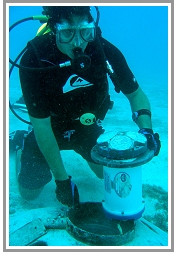Over the years, the AOML SFP and its affiliated field operations,
have enabled scientists and resource managers to keep a watchful eye on the
sensitive marine habitats found in the region and have served as a sentinel
during periods when the ecosystem has been subjected to extreme events such
as hurricanes, harmful algal blooms (HAB), and potential oil spill contaminants.
Additionally, the AOML SFP has produced a comprehensive, long-term
baseline for regional circulation, salinity, and water quality for the ecosystem.
The AOML SFP integrates data from environmentally and economically important
areas, including three national parks (Biscayne,
Everglades, and the
Dry Tortugas) as well as the Florida Keys
National Marine Sanctuary (FKNMS). Economic activity associated with the
FKNMS alone was worth $6 billion and 71,000 jobs in 2001.
Sustained measurements that have been supported by the AOML SFP include synoptic interdisciplinary
bay-wide and regional shipboard surveys, a moored oceanographic instrument array, and
Lagrangian surface drifter deployments.

